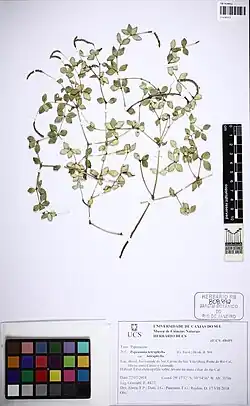Peperomia tenella
| Peperomia tenella | |
|---|---|

| |
| Scientific classification | |
| Kingdom: | Plantae |
| Clade: | Tracheophytes |
| Clade: | Angiosperms |
| Clade: | Magnoliids |
| Order: | Piperales |
| Family: | Piperaceae |
| Genus: | Peperomia |
| Species: | P. tenella
|
| Binomial name | |
| Peperomia tenella | |
| Synonyms | |
| |
Peperomia tenella, known as the Jayuya, is a species of perennial, lithophyte or epiphyte in the genus Peperomia.[1][2] It was first described by Olof Swartz but named it Piper tenellum.[3] Albert Gottfried Dietrich then changed the species into Peperomia and published in the book "Species Plantarum. editio sexta 1: 153. 1831".[4] It primarily grows on wet tropical biomes.[1] The species name came from the Latin word wikt:tenellus, which means tender.
Description
It has a straightforward decumbent stem with an ascending spike and two oval, ciliated leaves.[3]
There are three to four uncial stems that are hairy, hardly striate, smooth, rarely split, and minutely reddish-dotted. The stems are little, quickly petiolate, attenuate, obtuse, vigorous, sub-succulent, glabrous, pale below leaves. Filiform spike terminal. Scales severed at the sprout's side. No style. Stigma villous. A pedicel that is three times longer than the shoot, this pedicellate berry is about the size of a tiny needle head.[3]
Subtaxa
Following subtaxa are accepted.[1][2]
- Peperomia tenella subsp. glabra C.DC.
- Peperomia tenella var. deltoides Trel.
- Peperomia tenella var. epiphytica Trel.
- Peperomia tenella var. glabra C.DC.
Distribution
It is endemic to Caribbean, Central America, and South America.[1][2]
References
- ^ a b c d "Peperomia tenella (Sw.) A.Dietr". Plants of the World Online. Royal Botanic Gardens, Kew. Retrieved 24 February 2024.
- ^ a b c "Peperomia tenella (Sw.) A.Dietr". Global Biodiversity Information Facility. Retrieved 24 February 2024.
- ^ a b c "Species plantarum". www.biodiversitylibrary.org/. Retrieved 24 February 2024.
- ^ "Peperomia tenella (Sw.) A.Dietr". Tropicos. Retrieved 24 February 2024.